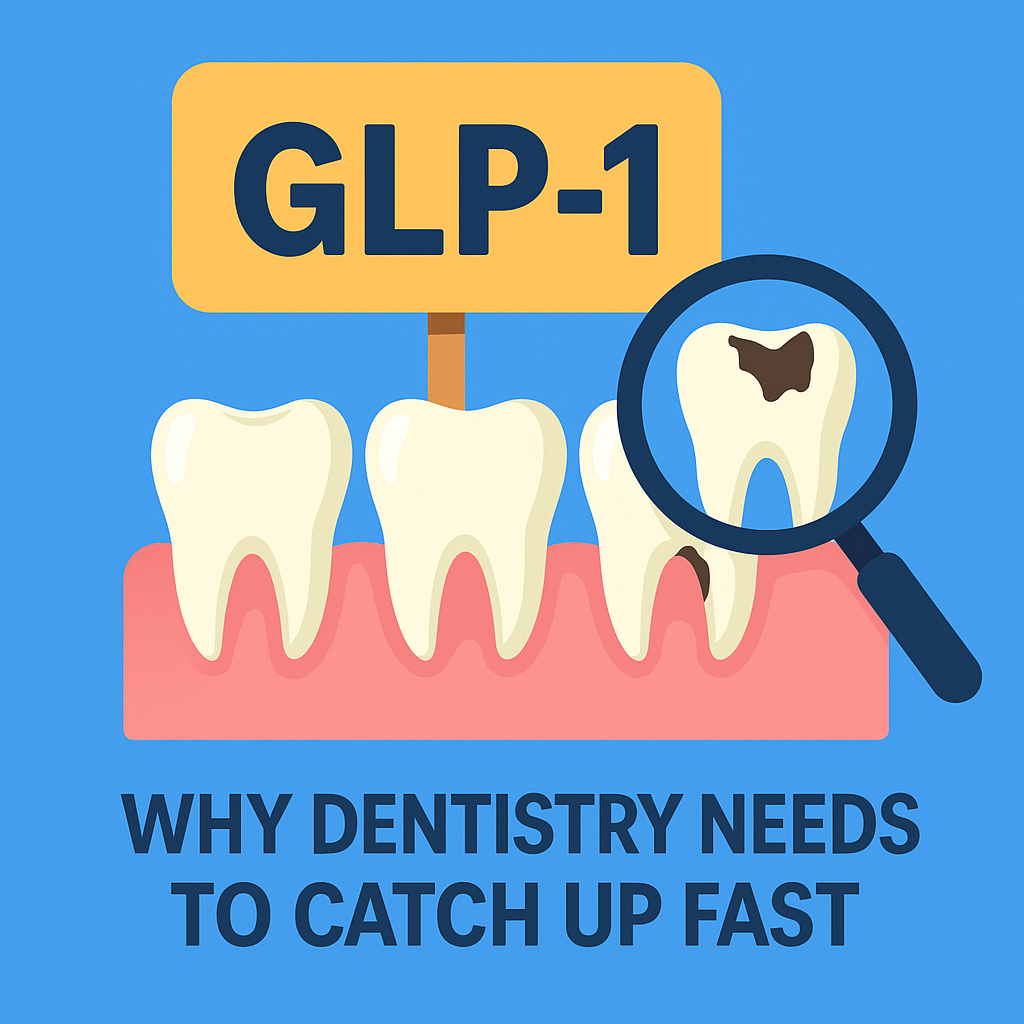The GLP-1 Blind Spot: Why Dentistry Needs to Catch Up Fast
October 19, 2025
Twelve million Americans are taking GLP-1 medications. That number is growing exponentially. And most dental practices have no protocol for managing the oral health complications these medications create.
This is a massive gap, and it’s going to bite us if we don’t address it.
The Problem We Are Not Discussing
I’ve been working with medically complex patients for years. Bariatric surgery patients. Cancer patients undergoing treatment. People managing multiple metabolic conditions. When GLP-1 medications started becoming mainstream, I immediately recognized the pattern.
These medications create:
- Severe xerostomia (reduced saliva production)
- Increased GERD and acid exposure
- Nutritional compromise affecting healing capacity
- Altered taste perception influencing dietary choices
Sound familiar? It should. It’s almost identical to the oral health challenges we see post-bariatric surgery.
But here’s the difference: bariatric patients are a relatively small population, and most practices have developed some level of awareness about their needs. GLP-1 patients are becoming mainstream. This isn’t a niche issue anymore.
What’s Falling into Practice
Most practices are handling GLP-1 patients the same way they handle everyone else. Six-month recalls. Standard fluoride protocols. Generic oral hygiene instructions.
That’s not enough. Not even close.
These patients need:
- Shortened recall intervals (3-4 months minimum)
- Aggressive dry mouth management beyond “drink more water”
- Modified home care protocols that account for compromised natural defenses
- Careful monitoring for early signs of caries and periodontal disease
- Pre-surgical optimization if they’re considering implants
- Enhanced education about acid management after reflux or vomiting
And critically, they need us to actually ask about these medications during medical history review. A lot of patients don’t mention them because they don’t think it’s relevant to their teeth.
The Implant Competition
This gets worse when you’re placing implants. Osseointegration requires adequate nutrition. Long-term implant success requires healthy saliva production and good tissue maintenance.
GLP-1 medications compromise both.
I’m not saying don’t place implants in these patients. I’m saying you need to:
- Do comprehensive nutritional assessment before surgery
- Modify your surgical protocols to account for compromised healing
- Plan for more intensive post-operative monitoring
- Implement rigorous maintenance schedules
- Use every tool you have (including laser protocols if you have them) to prevent peri-implantitis
The patients who develop peri-implantitis in their 40s and 50s? Increasingly, GLP-1 medications are part of the picture. The dry mouth creates an environment where bacteria thrive around implants. By the time they have symptoms, you’ve often lost significant bone.
The Sedation Safety Issue
Here’s something most dentists aren’t aware of: GLP-1 medications significantly delay gastric emptying, which increases aspiration risk during sedation.
This isn’t theoretical. This is a documented anesthesia concern that your medical colleagues are very aware of. Extended fasting protocols. Medication holds. Modified sedation approaches.
If you’re doing sedation dentistry and you’re not specifically asking about GLP-1 medications and adjusting your protocols accordingly, you have a liability problem.
Why this matters for your practice
Beyond the clinical concerns, this is a strategic opportunity. The practices that develop real expertise in managing GLP-1 patients are going to attract a significant patient population that most dentists are underprepared to handle.
This is similar to what happened with Invisalign. Early adopters who actually learned the system well built substantial practices around it. Dentists who bought the scanner but never really invested in understanding the biomechanics struggled.
GLP-1 oral health management is headed the same direction. You can be the practice that handles these patients well, or you can be the practice that watches complications develop and doesn’t understand why.
What the Profession Needs
We need continuing education that actually addresses this. Not as a footnote in a medical history update, but as a specific focus area. What are the actual complications? What protocols work? What’s the evidence base?
We need better integration between medicine and dentistry. When physicians prescribe these medications, they should be telling patients to see their dentist more frequently and be alert for oral health changes. That’s not happening systematically.
We need to stop treating medical complexity as someone else’s problem. Your operatory isn’t a bubble separate from the rest of the patient’s health. Their medications affect your outcomes. Their nutrition affects your surgical success. Their medical conditions determine whether your treatment plan is even viable.
Where I see this Going
In five years, managing GLP-1 implications will be standard dental education. Practices will have specific protocols. Insurance companies will recognize the need for more frequent monitoring in these patients.
But right now, we’re in the early phase where most dentists are behind the curve. The patients are already in your chairs. The medications are already affecting their oral health. Whether you’re prepared to handle it or not, it’s happening.
I teach implant surgery to dentists around the country. This is increasingly part of the conversation. Not as a theoretical future issue, but as something we’re seeing in practices right now. Failed implants in GLP-1 patients who never had adequate monitoring. Aggressive periodontal disease progression in patients whose dry mouth was never properly managed. Surgical complications in patients whose nutritional status was never assessed.
These are preventable problems. But prevention requires awareness, protocols, and commitment to managing these patients differently than the standard approach.

